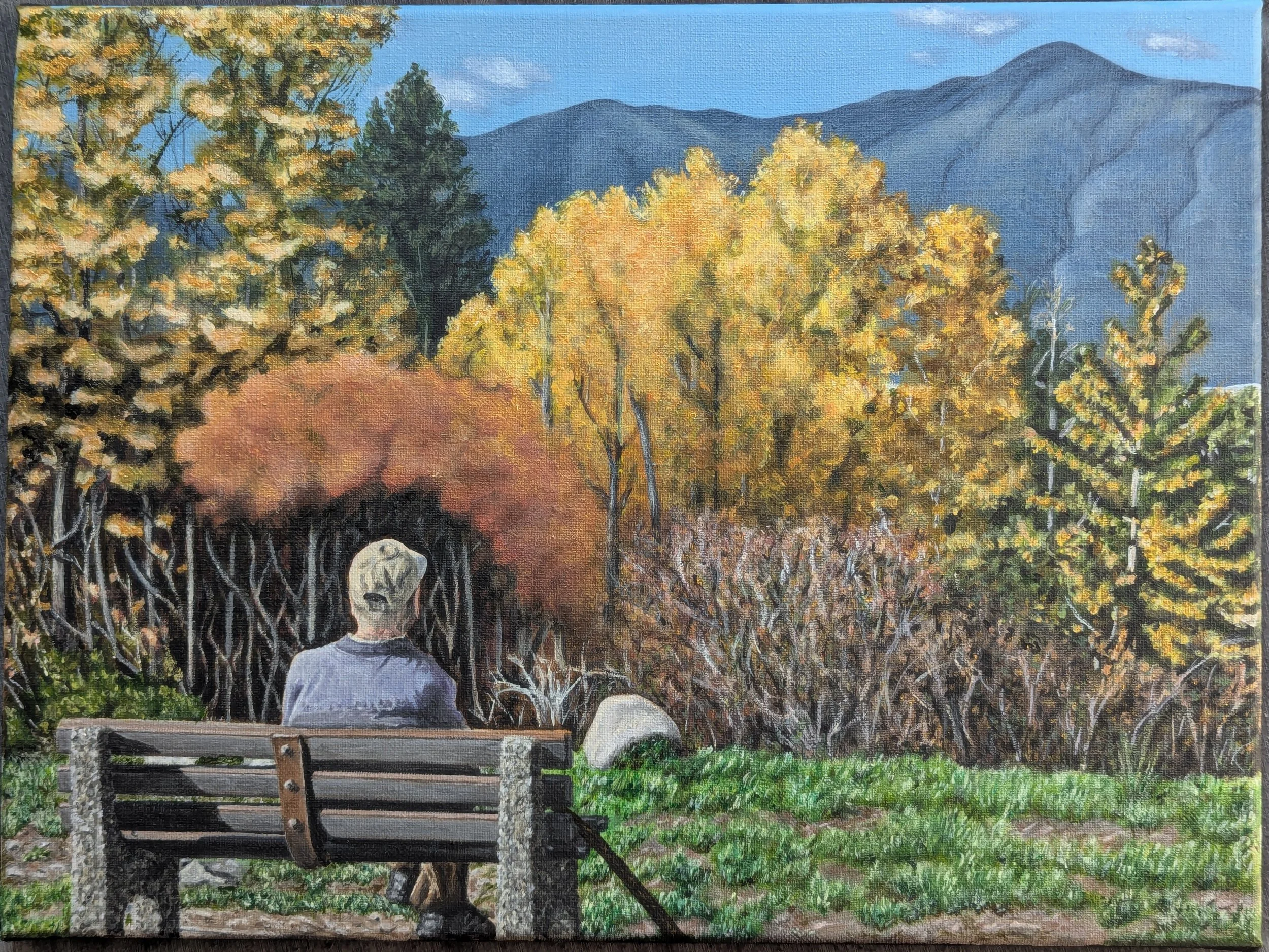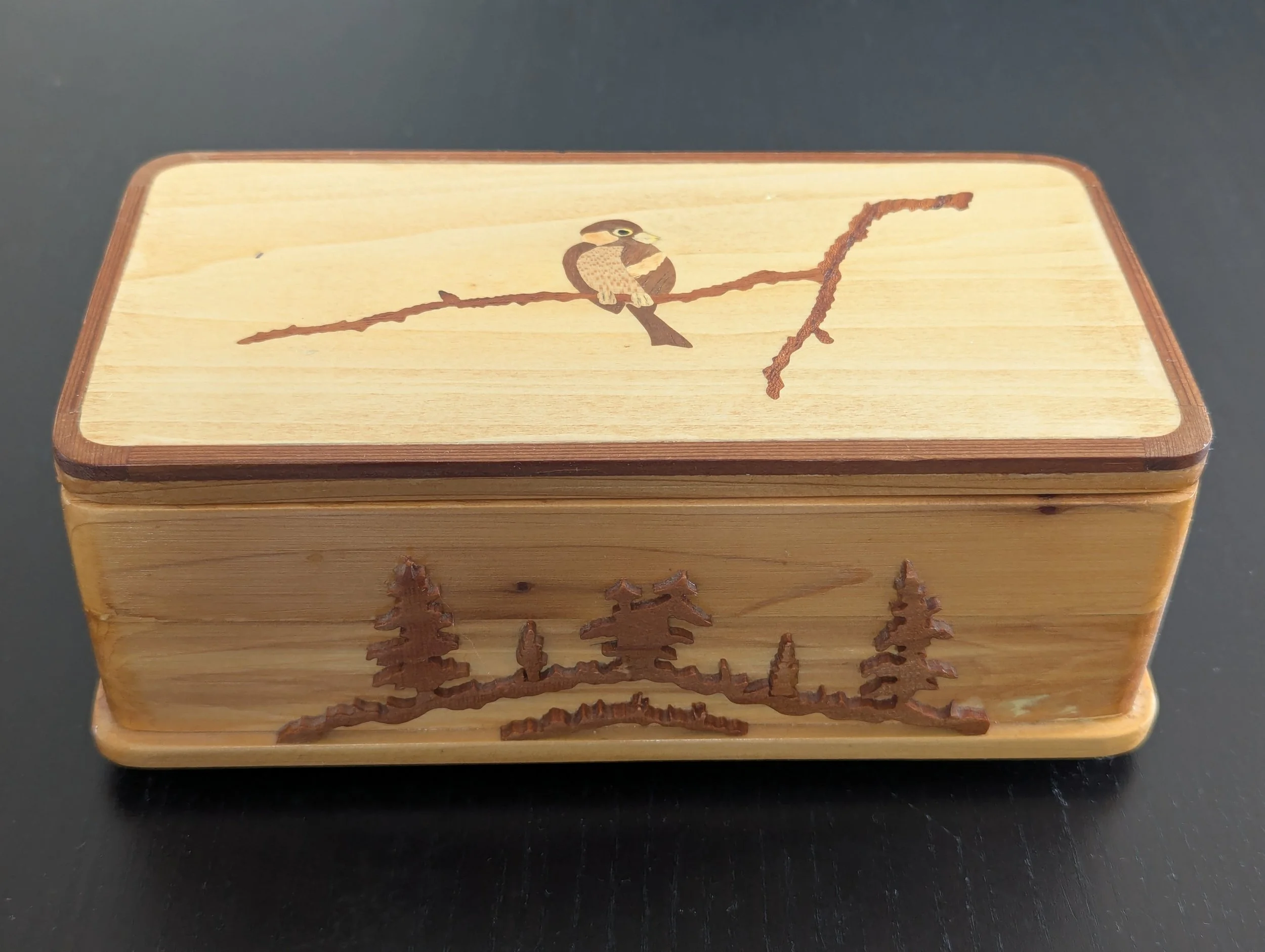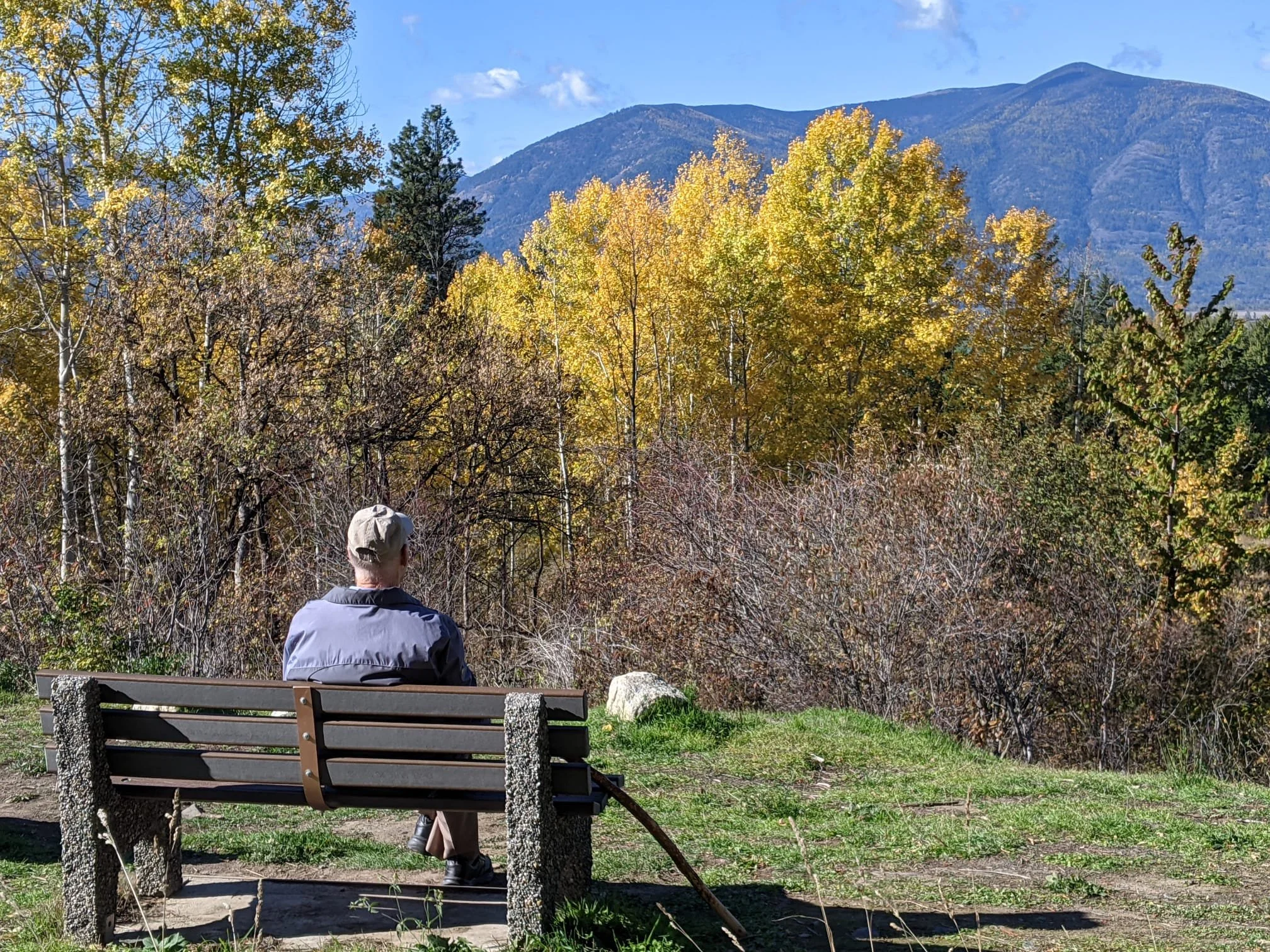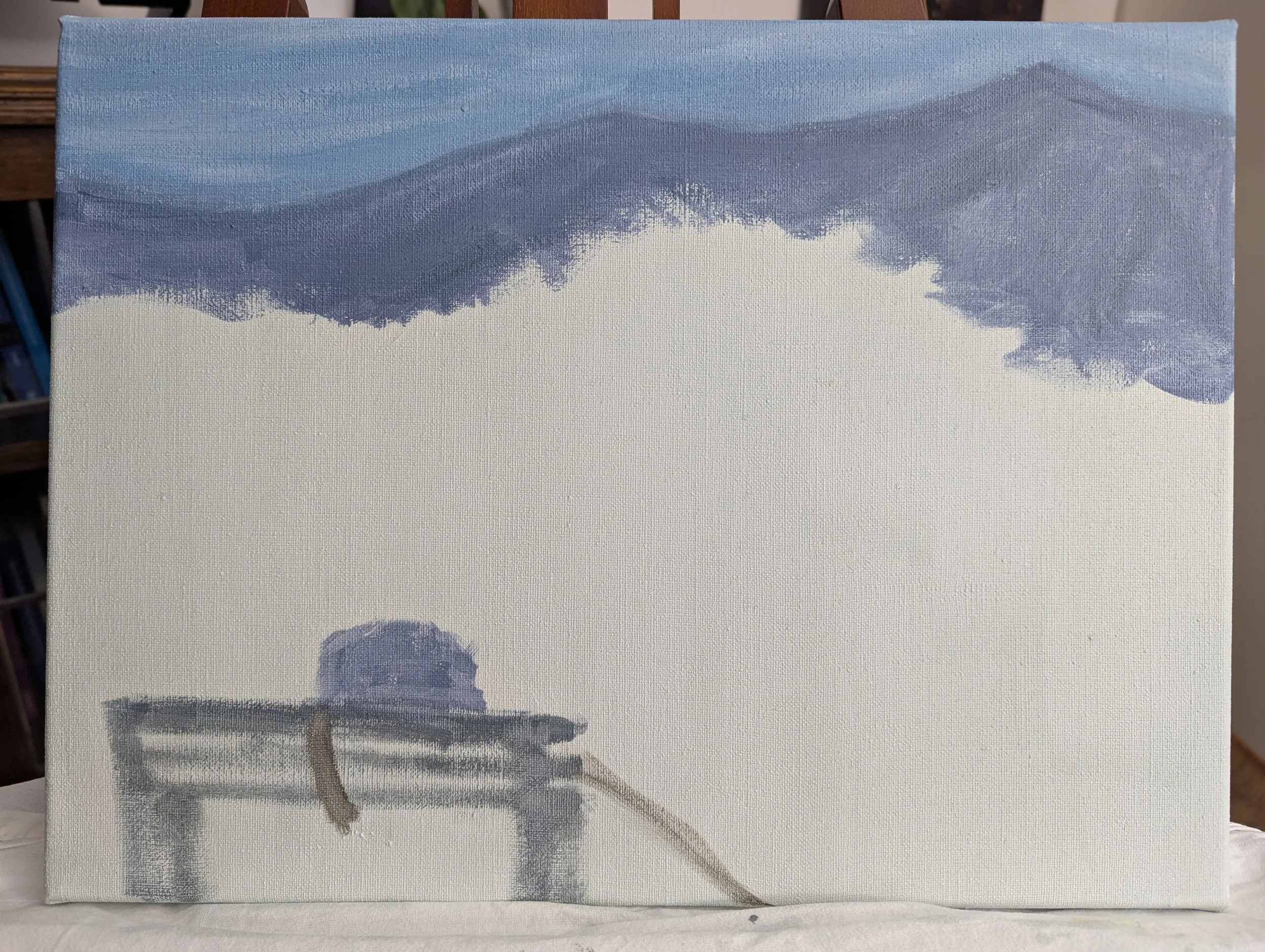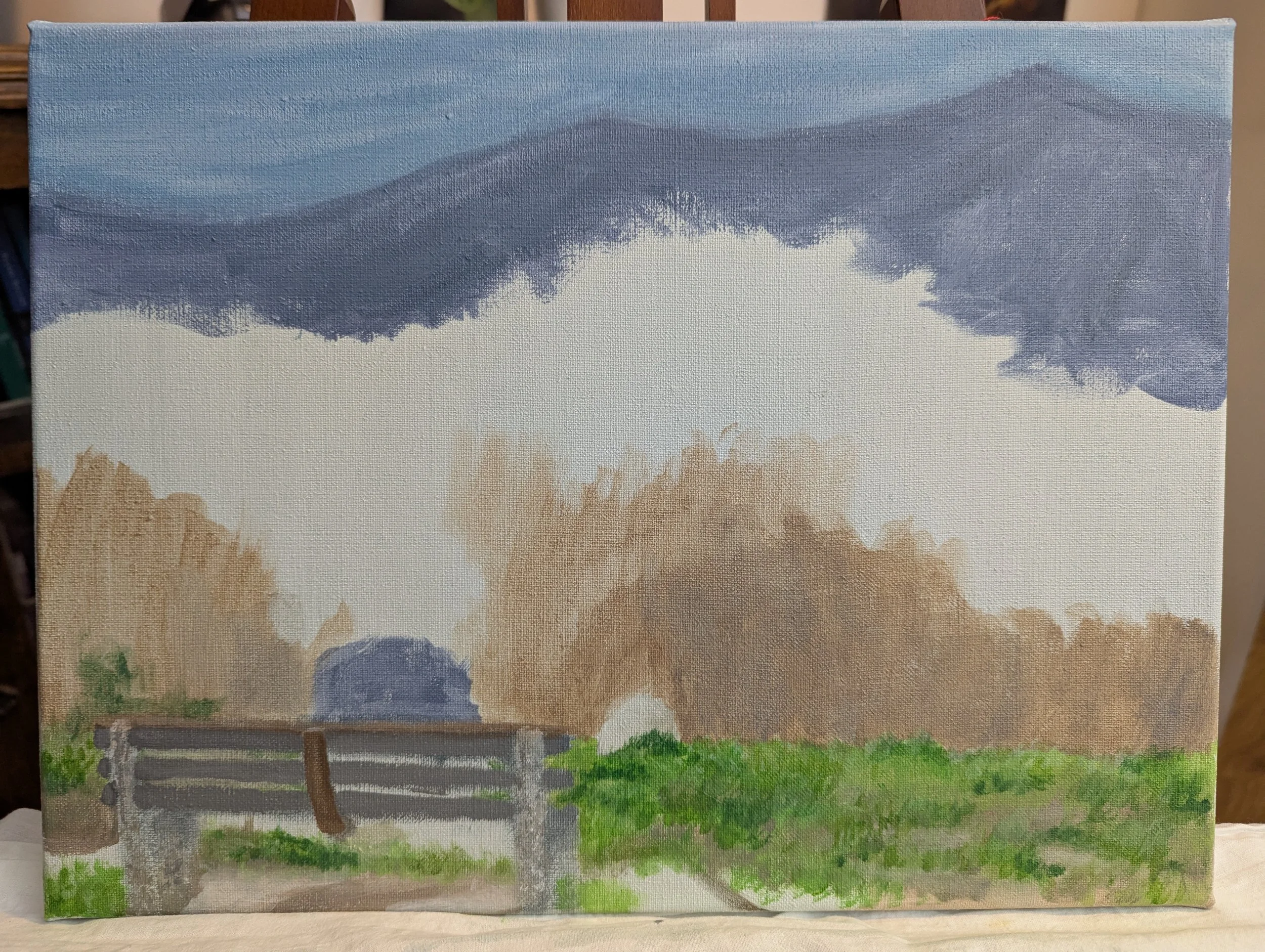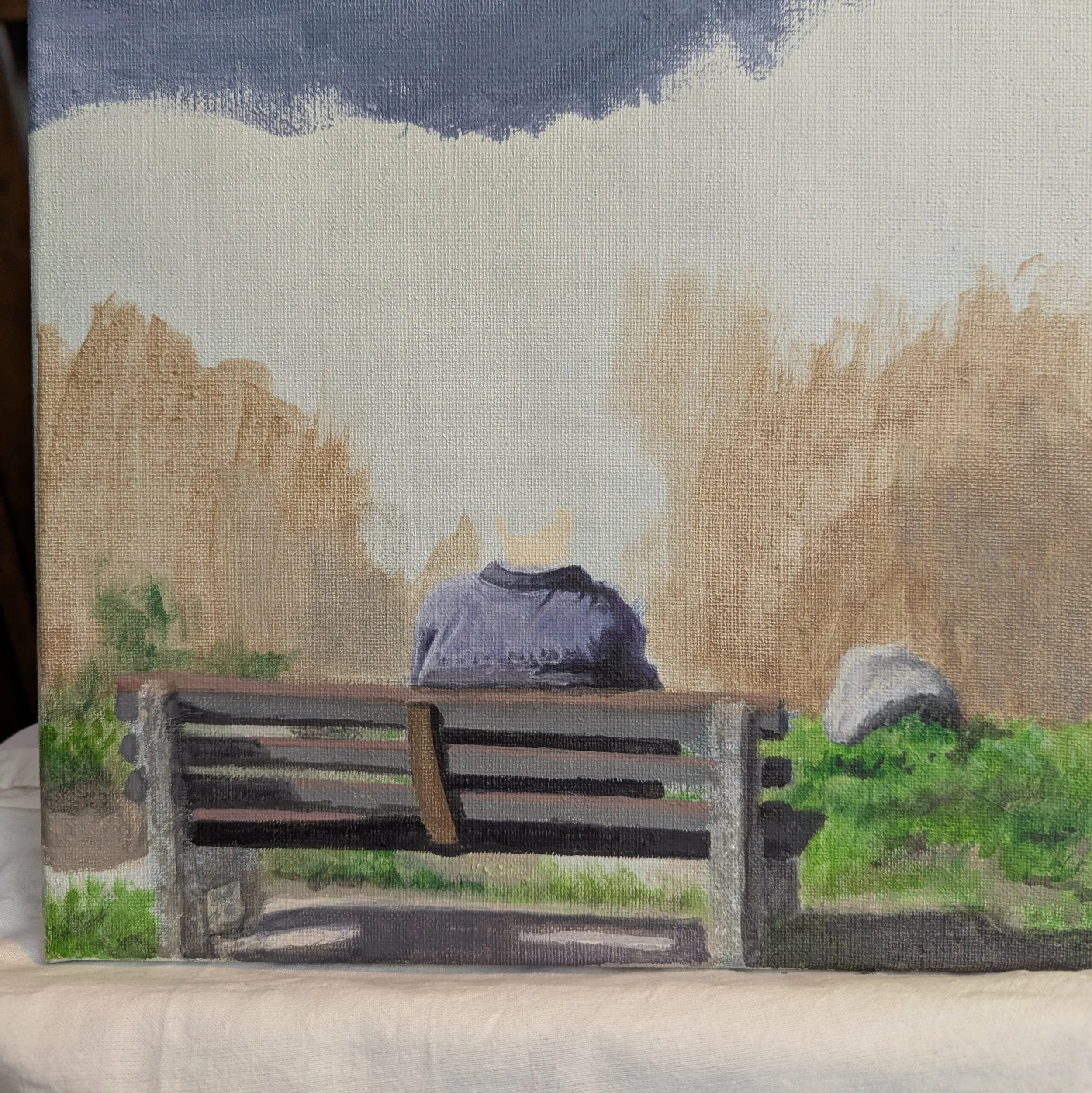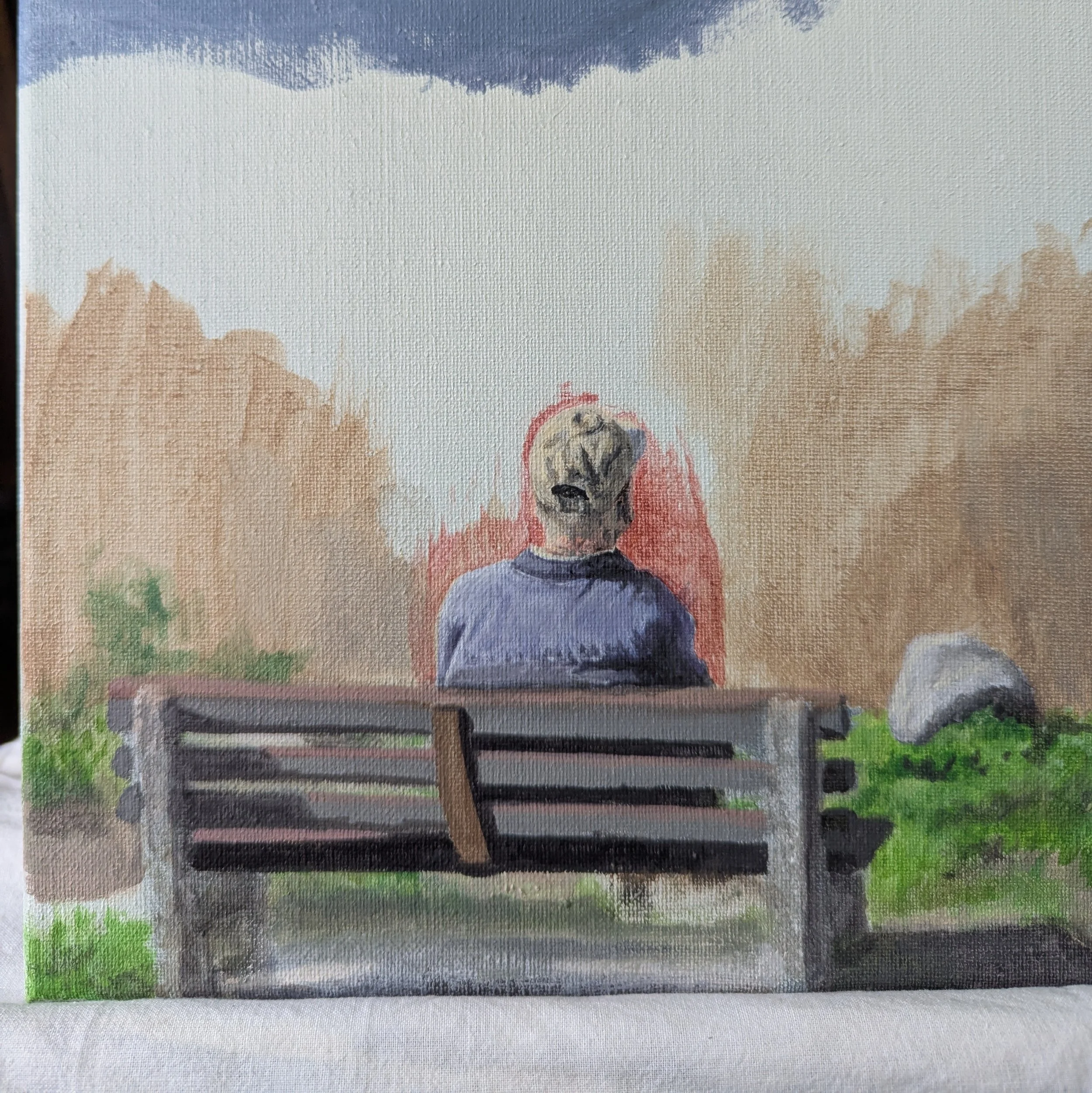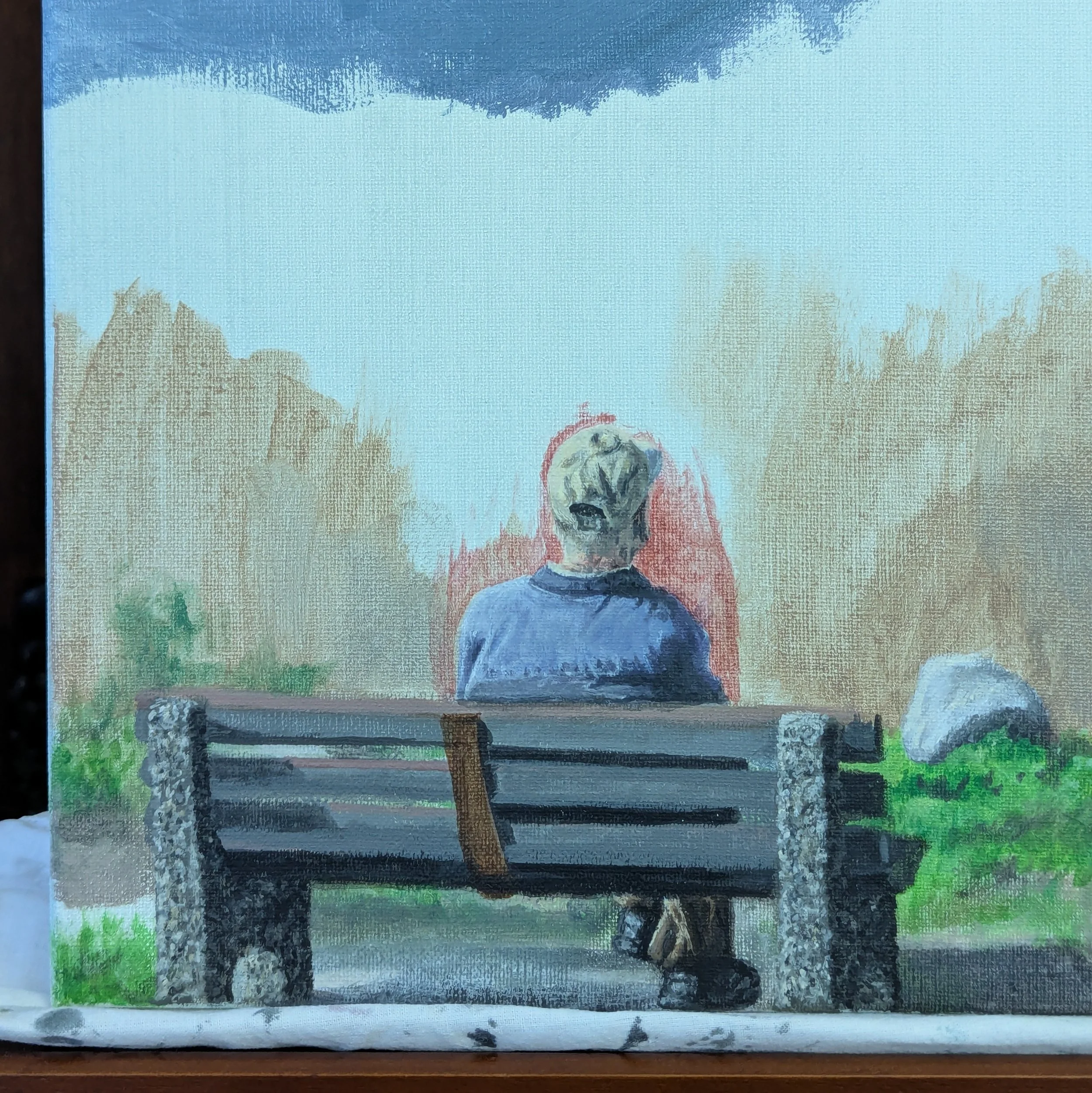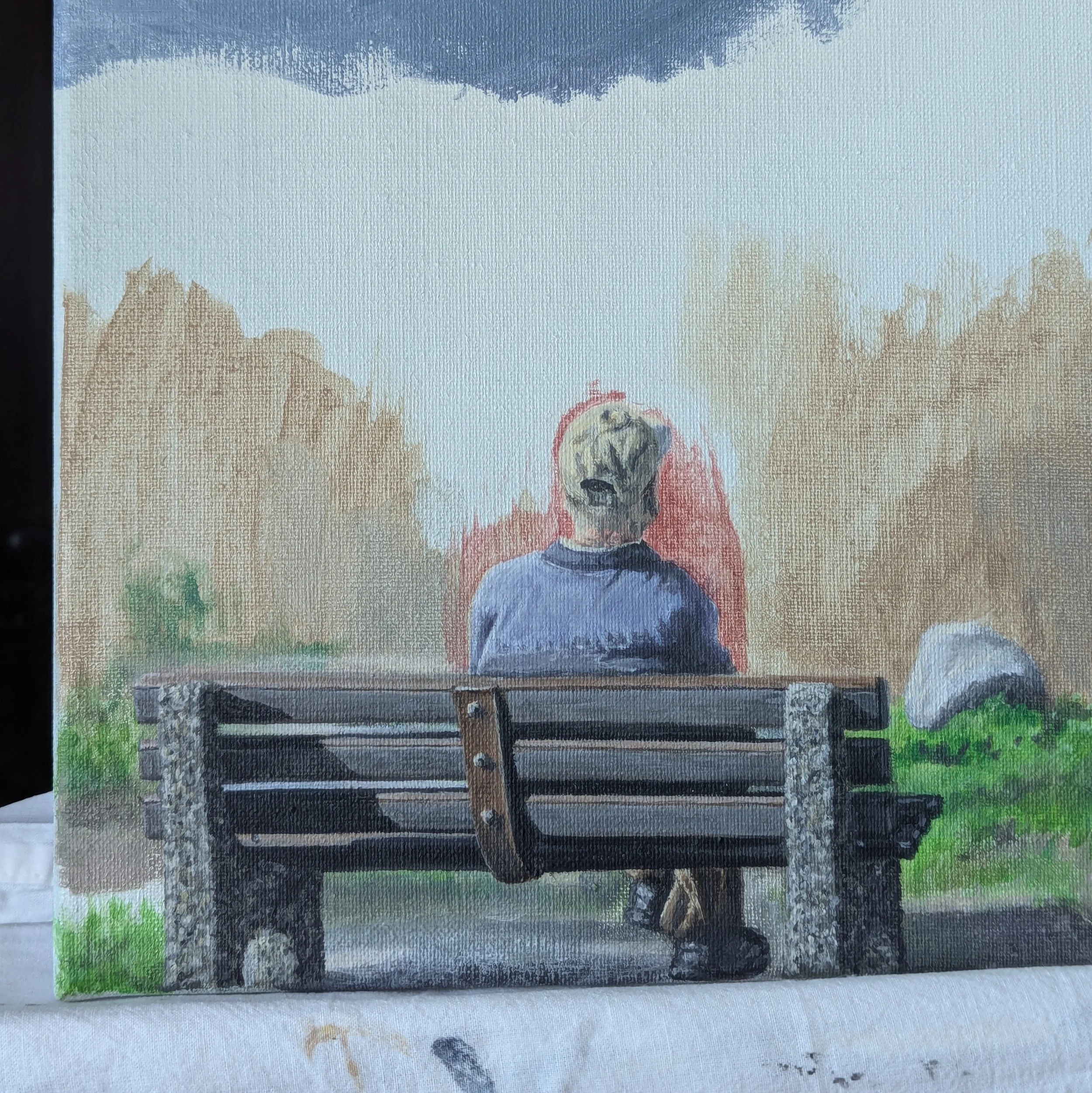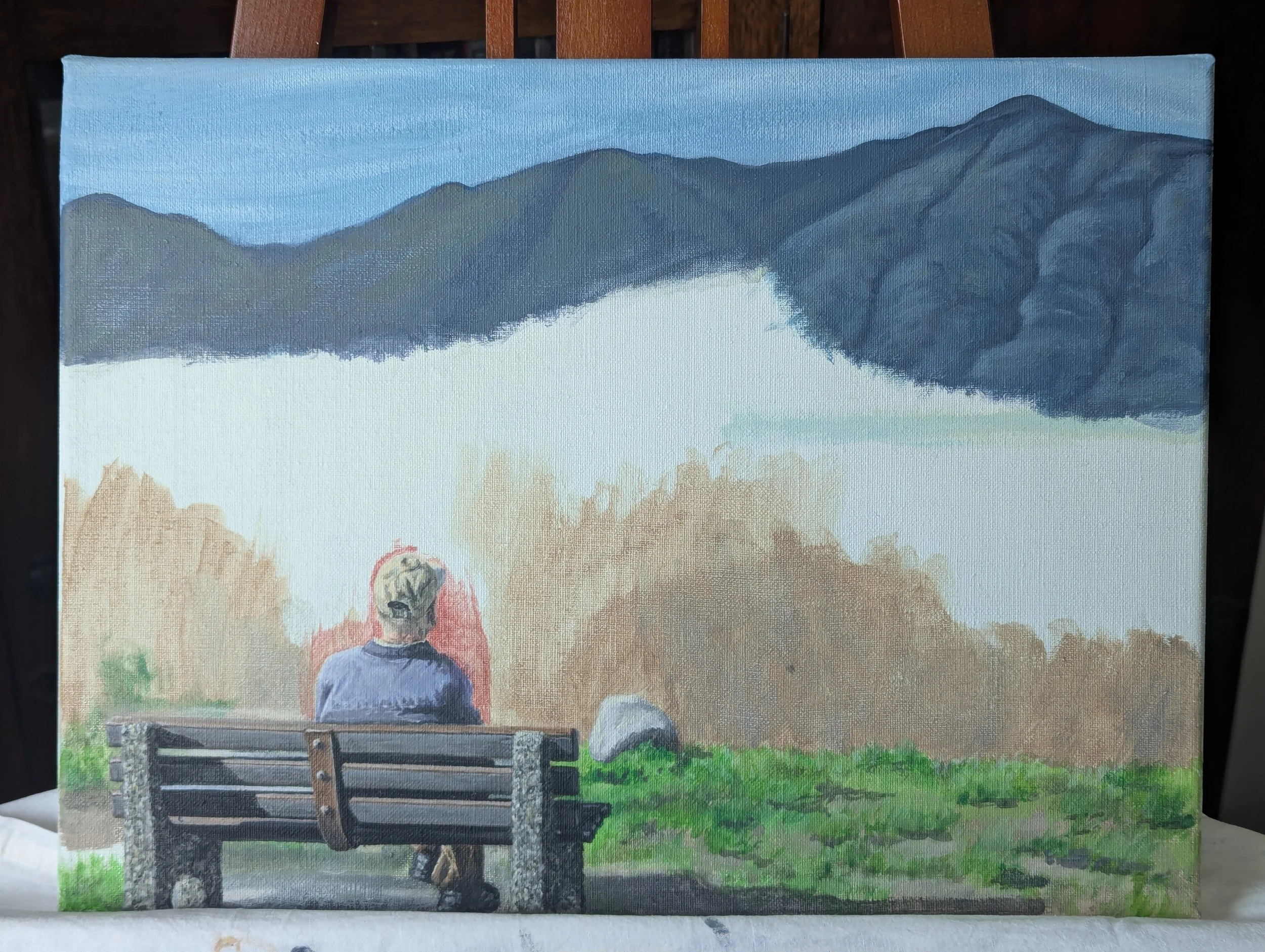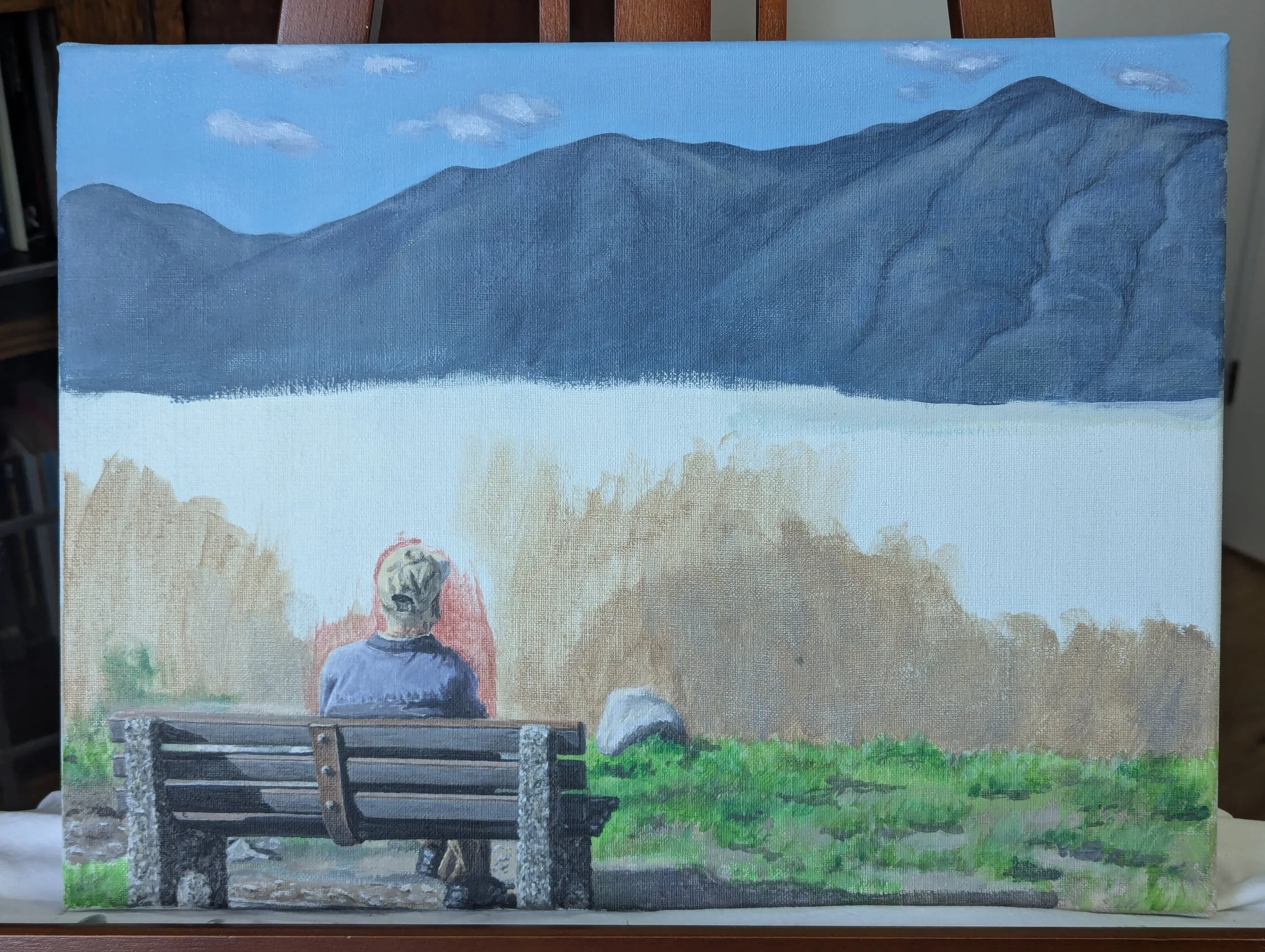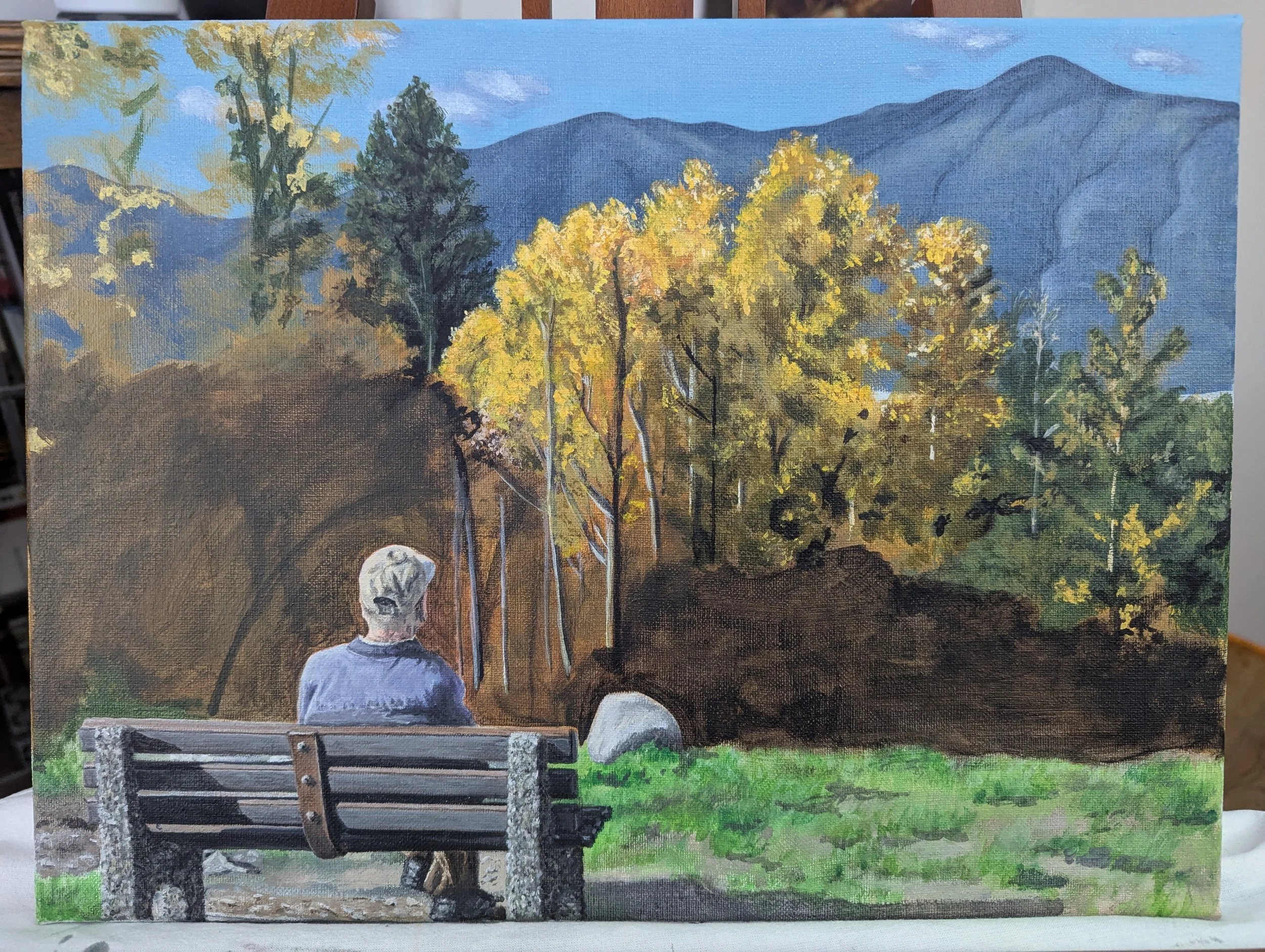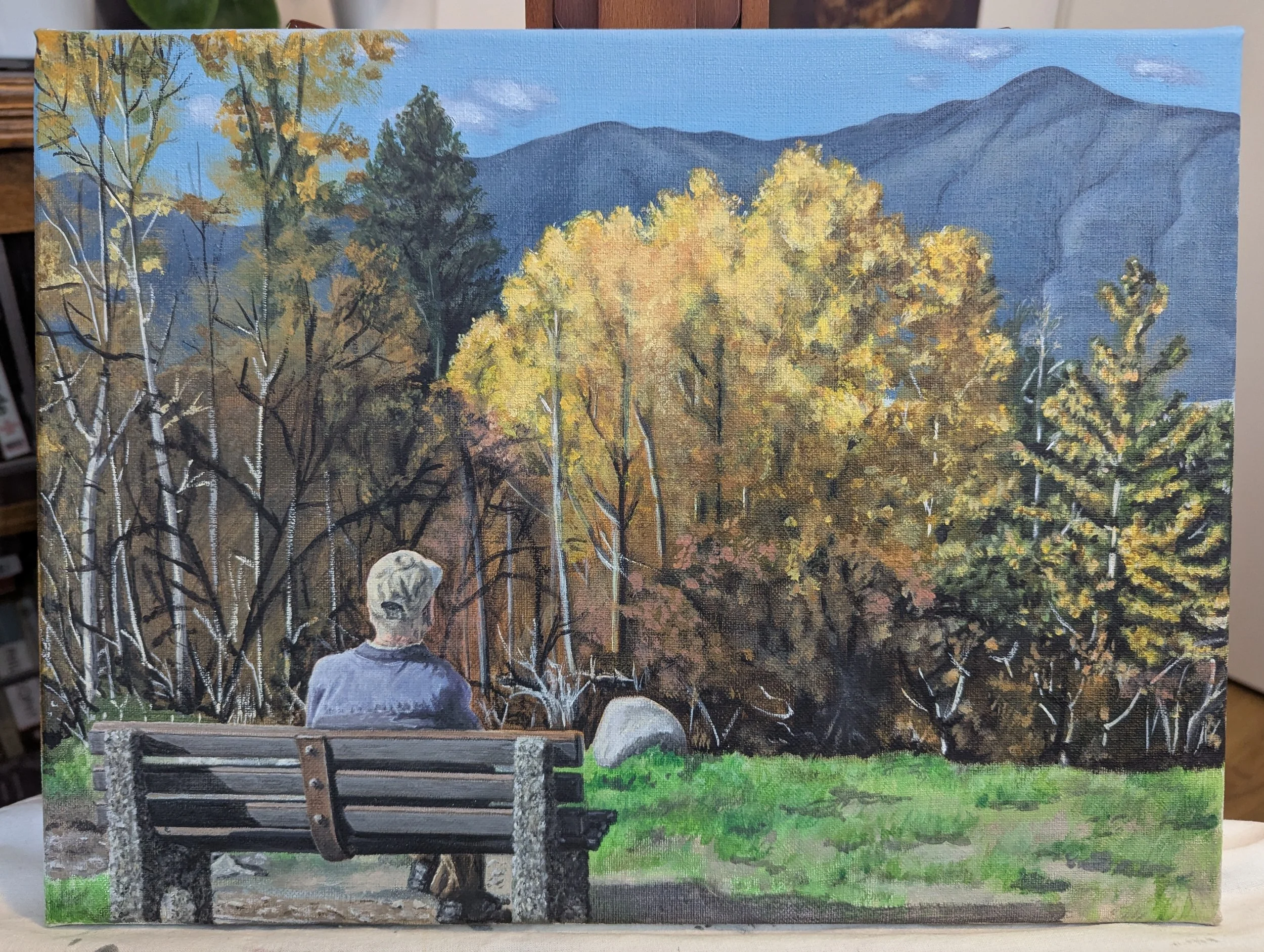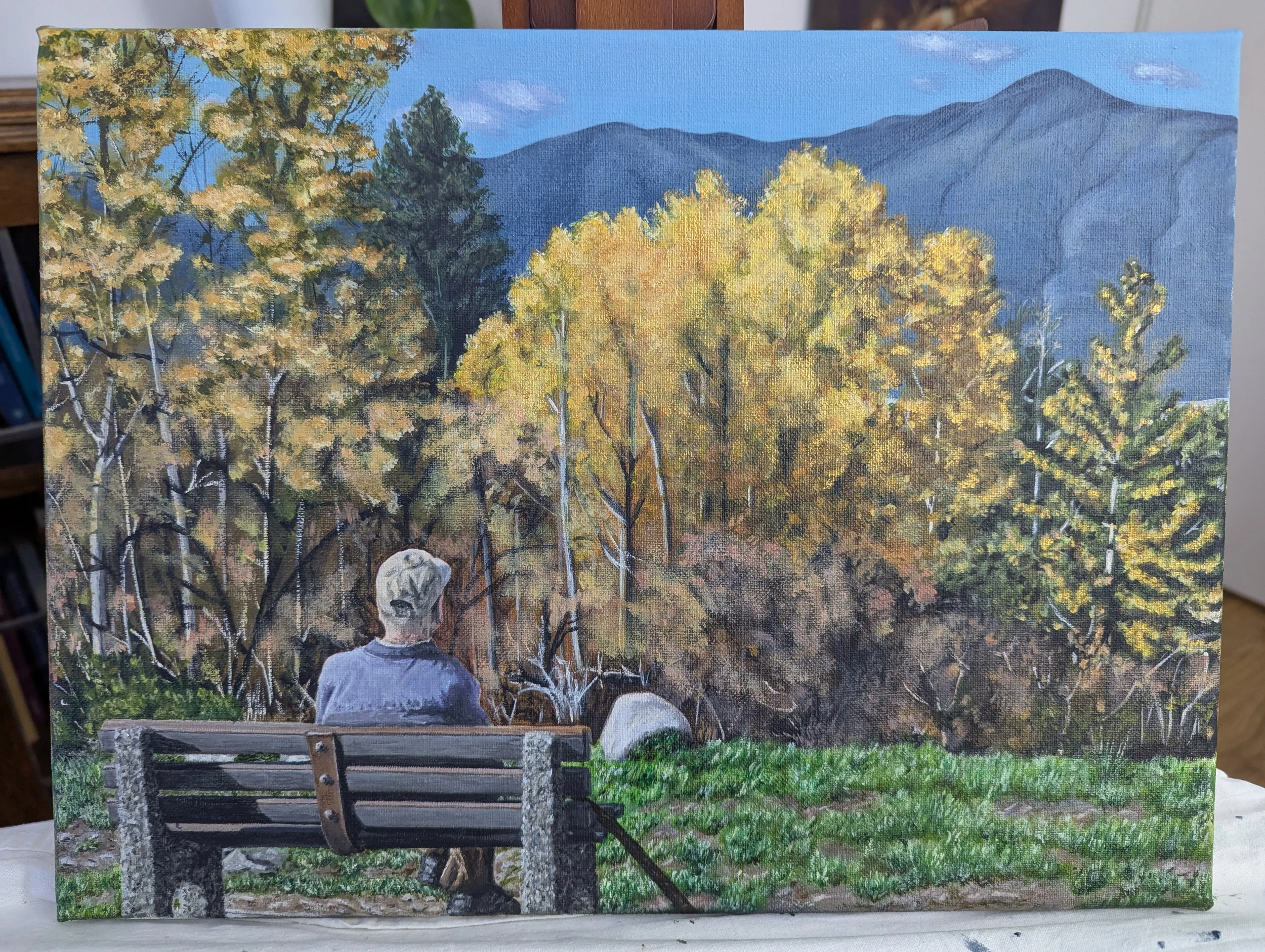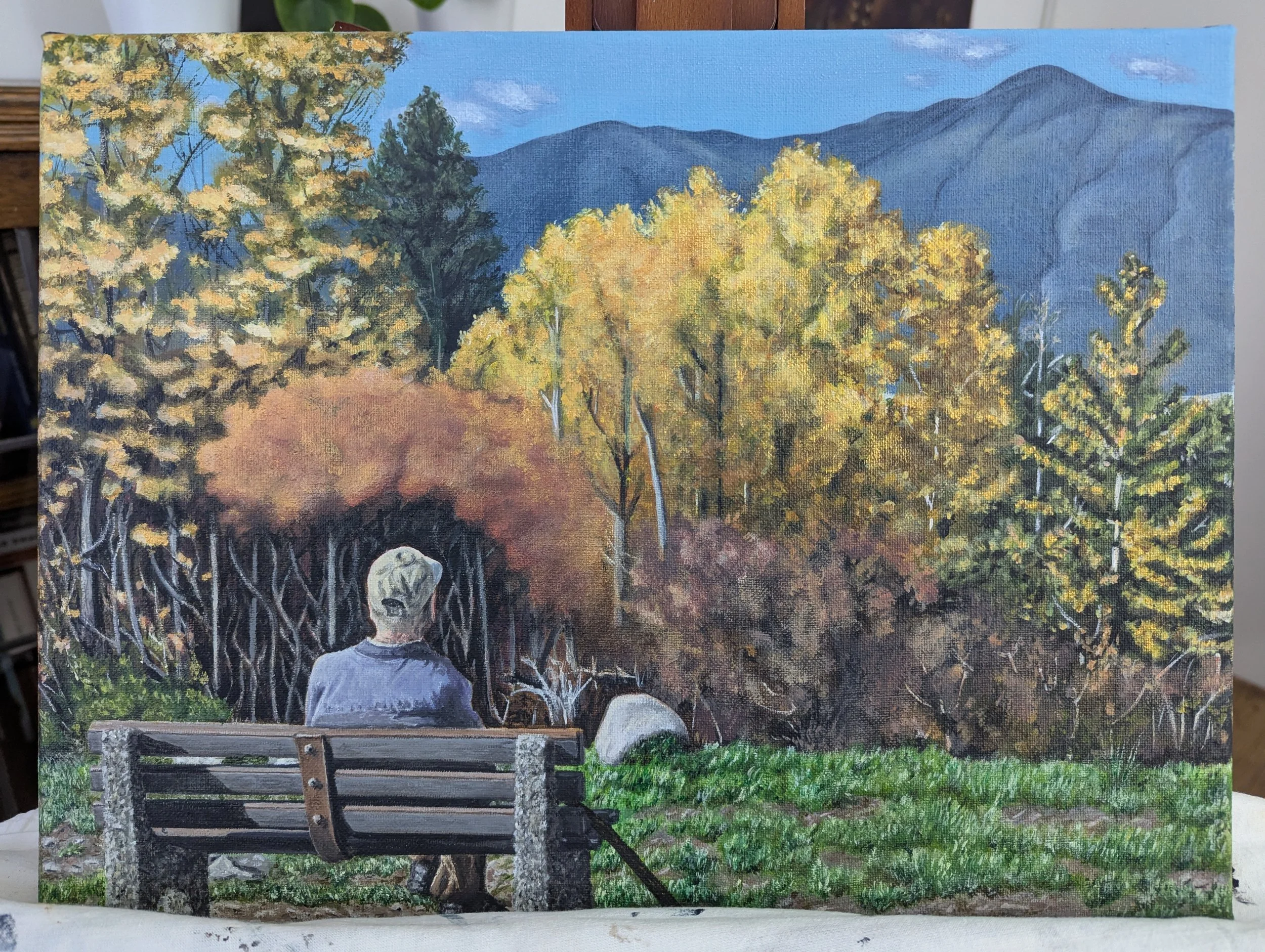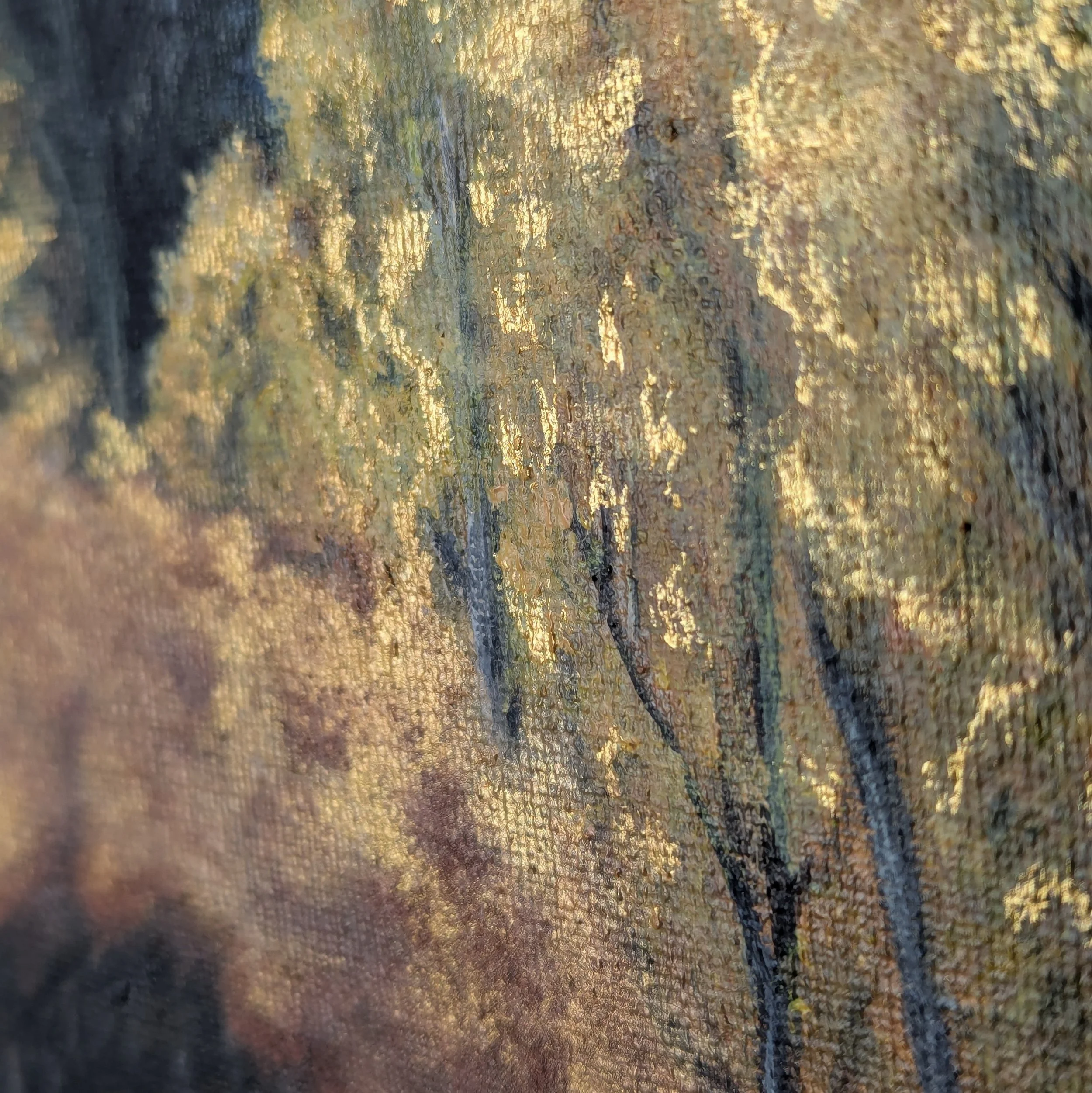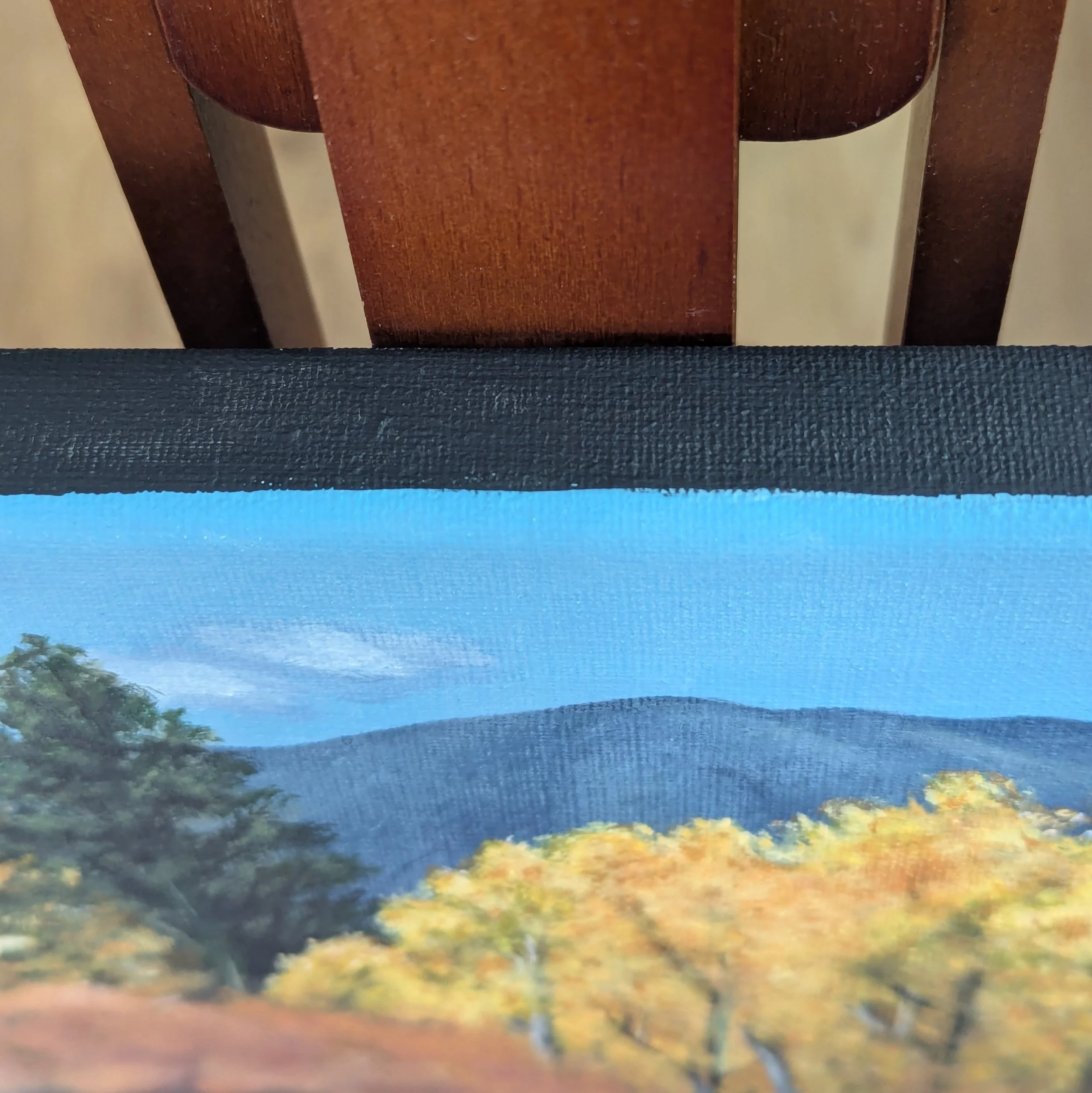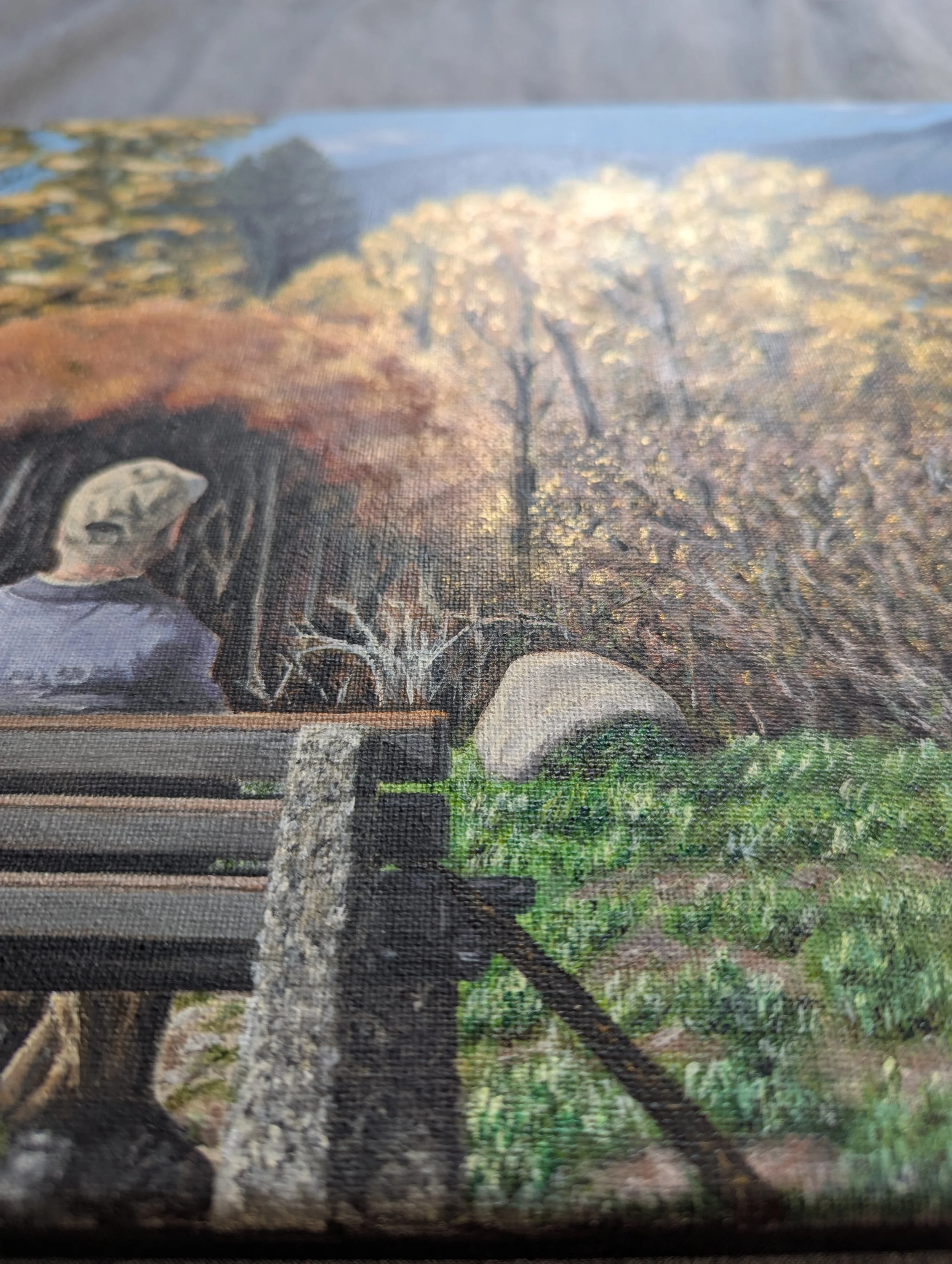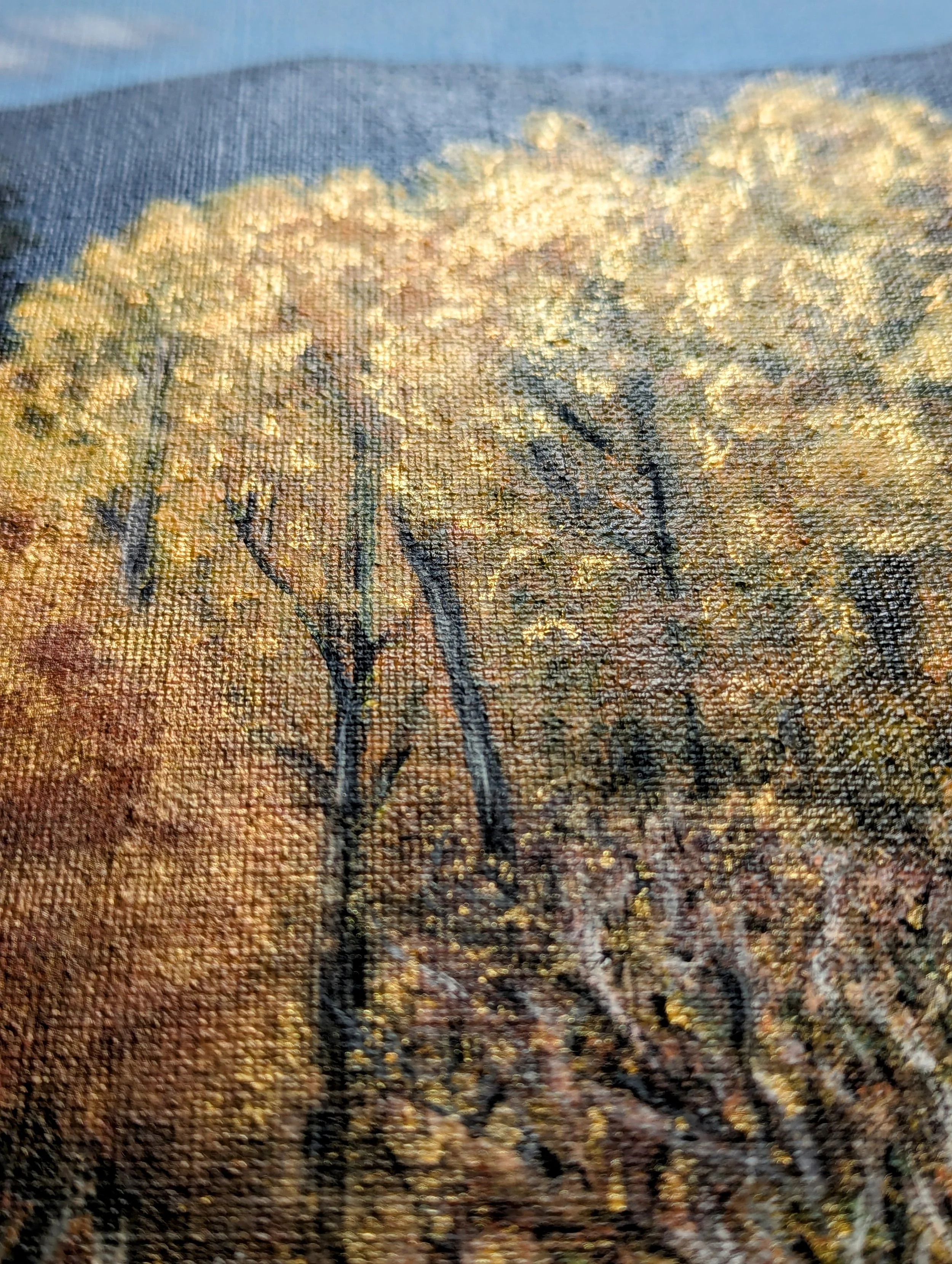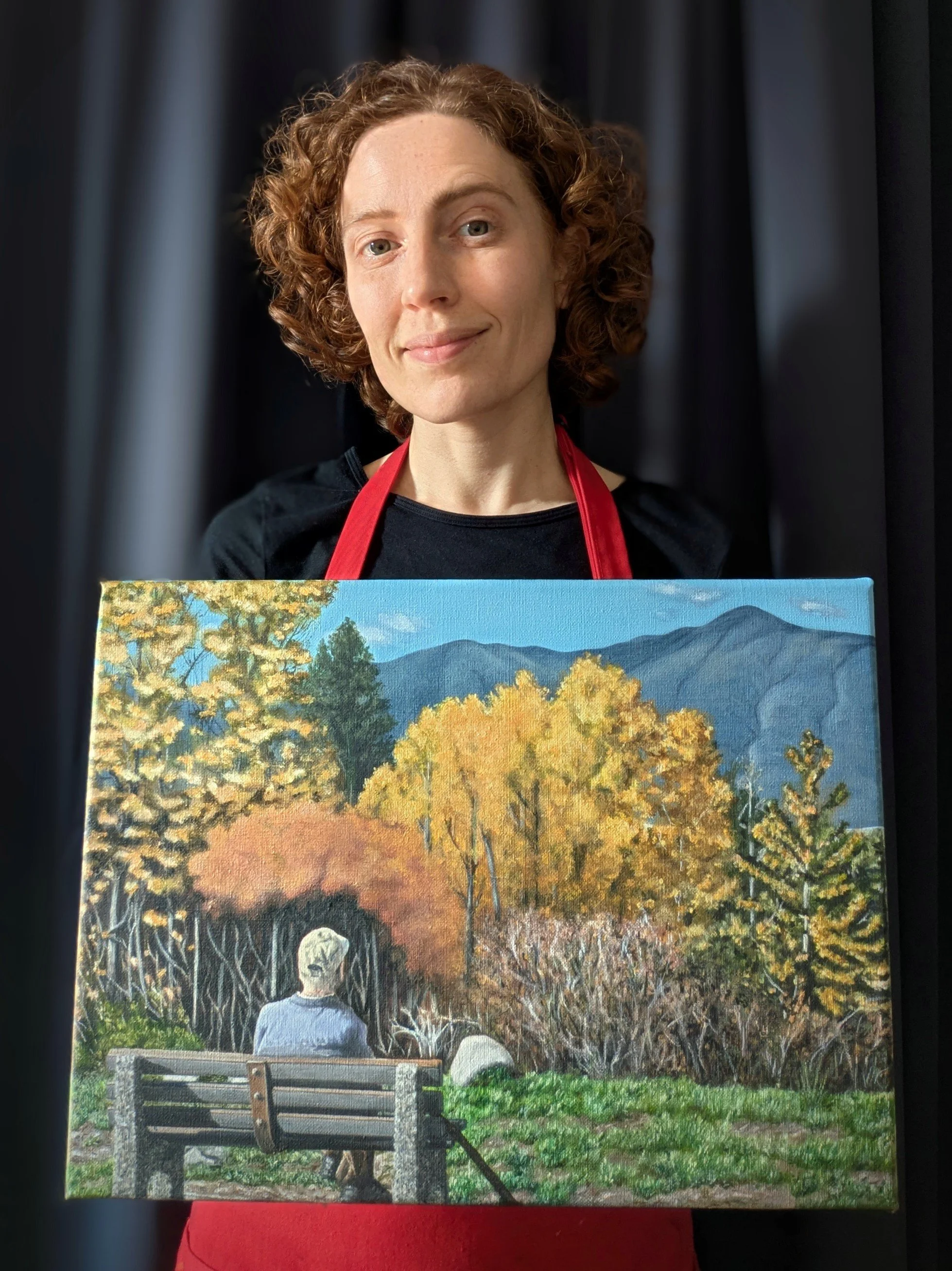“Opa's Bench” - Acrylic Painting of Creston Valley
“Opa's Bench” (acrylic on canvas, 30 × 40 cm)
Last month, my Opa (my maternal grandfather) passed away at age 99. As a tribute to his life, I painted this portrait of him sitting on his favorite bench in British Columbia. Even in his final months, he enjoyed walking up the hill to this bench and gazing at the beautiful mountains of Creston Valley.
Besides nature, my Opa loved poetry, drawing, woodworking, and taking/developing photos. He was a curious, detail-oriented man whose creativity was precise and elegant. For instance, he made jewelry boxes from various pieces of wood cut so carefully, they looked like a single piece, smooth and flawless.
In honor of his meticulous approach to art, I wanted to paint this scene with a lot of detail. It's a gift for my Oma, who was a dedicated wife for 72 years and will be turning 99 in May.
Reference photo for “Opa's Bench”
The Process
As usual, I started this painting with a loose sketch just to break the ice. Typically I only need one session of sketching, but this time, I needed two sessions of messy painting to get over the initial apprehension of facing a blank canvas.
I'd never done a detailed landscape painting before, and since it was going to be a gift, I created plenty of time for each step. Going slowly was important for the emotional side of this process. I didn't want to rush anything, least of all a painting of my Opa for my Oma.
Especially while working on the bench and portrait, I felt compelled to go slowly and fiddle with colors for longer than I usually do. For example, I spent a whole hour on his hat because it felt peaceful, like a meditative exercise.
Outwardly, I was painting, but inwardly, I was recalling memories and spending time with my Opa.
I did the portrait before everything else because it was the most important part of the painting to me. Once it was done, I felt at ease and could focus on the mountains, the layer farthest away or ‘under’ the trees. I initially used dark blue and yellow ocre (which made green), but later added some red for a purple tinge, since purple and yellow are complementary colors.
To create a sense of distance with haziness, I whitewashed the mountains and sky. I love layering colors, especially thinning down one color and spreading it over other colors. It might be my favorite technique with acrylic paint.
By that point, I was getting tired of the messy blank space in the middle of the canvas. I filled it up with color, sketched out the different sections of trees, and started with the pine trees farthest away.
I was looking forward to doing the batch of trees in the middle - all that yellow! But when the day came, I discovered those trees were more challenging than I'd thought. Sometimes clumps of trees are simplified into a few tones mixed together, but for this painting, I wanted more complexity. Layers upon layers.
Looking at the trees, I saw a rich variety of yellow, and I wanted to include EVERYTHING. But everything was too ambitious, so I decided just to keep working on them little by little as I finished the rest of the painting.
That complexity of color wasn't just a challenge with the tree foliage, though. Every part of the middle section had so many colors, I got lost while painting and felt a little overwhelmed.
I first tried to paint exactly what I saw. “Just choose a color and fill in the blank spaces like a paint-by-numbers,” I thought. It sounded simple, but in practice, it felt like putting together a 2000-piece puzzle of tiny dots. Trying to identify and match those dots was so frustrating, I soon abandoned that approach.
Despite my frustration, that session had one highlight: I discovered gold paint! The gold shine is hard to capture on camera, but it's really lovely in person.
Instead of focusing on color, I began thinking about overall structure. I mapped out the middle section with tree trunks and limbs, which I planned to paint over later.
Though less attractive than colorful dots and gold paint, those messy limbs were a huge relief. They gave me a stronger grip on the painting, like trail markers so I wouldn't get lost while layering the colors.
Before tackling the foliage, I decided to make the grass prettier. When I'd painted the bench, I'd changed the proportions of the painting so there'd be more grass, less shadow, and fewer patches of open ground. In other words, the bottom of the painting was going to be filled with hundreds of grass blades, singled out with reflected sunlight.
Painting individual grass blades sounded tedious, but if I simplified the grass too much, it'd look odd compared to the rest of the painting. It needed enough detail to match the bench, at least, so I put on some music, sat down with a tiny brush, and put in those little rocks and grass blades.
Now I had to solve a problem I'd been avoiding: how to make my Opa stand out in the painting despite all the beautiful autumn colors and branches crowded around him. The prettier I made the scenery, the more he became a secondary subject rather than the focus of the painting.
I wanted to keep the painting realistic, but for this part, the reference photo wasn't much help. I needed a few sessions of playing around to figure out a solution that highlighted my Opa while still keeping the trees beautiful.
I ended up using a classic compositional technique - framing - which can highlight a subject even in a crowded image. There are several frames around my Opa: the vertical tree trunks, the arching tree foliage, and the darkness so different from the bright surrounding colors.
At first, I hesitated to put gloomy darkness around my Opa, but it ultimately seemed right and appropriate, given how many dark times he experienced, such as being drafted into the German army at age 18, fleeing for his life, and losing his friends in the war.
Yet despite being surrounded by darkness at times, he still had faith in the future, a zest for life, and a deep appreciation of beauty. Just like in this picture, he kept his eyes on the mountains and was grateful for his good health, home, and marriage.
During those sessions, I also finished the yellow trees with gold paint. Though difficult to see in these images, all the trees shine with gold paint. I especially love how the gold blends between the trees, so they're both unified and separate.
I painted the sides of the canvas, too. Many artists use dark brown or black paint, or else continue the painting onto the sides. I chose black paint, since it matched the painting the best.
The final session was simple and delightful. I painted the bushes in the middle right side with lots of layers, including a final layer of gold leaves, which made the bush look fairy-like. Again, I tried to capture all the gold in a photo, but my attempts fell short of reality.
To experience the gold, you'll have to see this painting in person, or else buy your own gold paint. (I used a cheap one from Søstrene Grene, so it doesn't have to be expensive to look pretty.) In any case, I'm hooked and certain to use gold again in future paintings!
